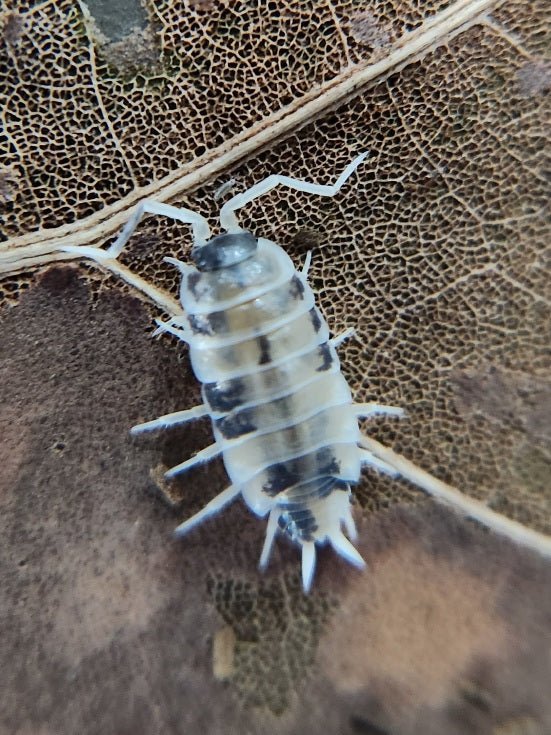If you have been searching for trusted isopod care information from an experienced source, you've come to the right place. We bought our first isopods in 2010 for our dart frog bioactive vivarium, and we have been keeping and breeding numerous species of isopods since 2012.
Many of the entry-level or common isopods have similar care requirements. Below is a quick overview of the basic care requirements that will set you up for success in keeping isopods happy and healthy. The details in this care guide are appropriate for the following isopods and many more species:
Porcellionides pruinosus, i.e., Powder Blue, Powder Orange, Powder Party Mix, Pink, Orange Cream, Oreo Crumble, Red Koi, Whiteout
Porcellionides floria
Porcellio scaber, i.e., Orange, Lava, Lottery Ticket, Snow Koi, Ghost, Whiteout, Lemonade, Calico, Orin's Calico, Dalmatian, Orange Dalmatian, Piebald, Orange Koi, Skewball Tri, White
Porcellio laevis, i.e., Dairy Cow, Milkback, Orange, White, Wild/Gray
Cubaris Murina, i.e., Little Sea, Papaya, Party Mix, Anemone
Armadillidium vulgare, i.e., Wild Type, Sunset, Magic Potion, St. Lucia
Trichorhina tomentosa Dwarf White
Dwarf Purple
Venezillo Parvus, Venezillo Parvus Dalmatian
1. Enclosure/Isopod bin - This can be as simple as a 6-quart Sterilite plastic shoebox. There are many types of enclosures that can be utilized as long as the enclosure has some ventilation.
2. Ventilation - Ventilation can be achieved by drilling several holes in one of the short sides of the plastic shoebox and then a drilling a few holes on each of the long sides of the plastic shoebox for some cross-ventilation. There are also some vendors who make specialized vents you can insert or add to your bin.
3. Substrate - An organic topsoil with dried leaves mixed in works very well. A depth of two to three inches of topsoil is sufficient for common species.
4. Humidity/Water - All isopods need some humidity/dampness to survive. Placing damp sphagnum moss at the opposite end as the ventilation holes will provide ample humidity. Place a one-inch layer of moss on top of the soil to cover 1/4 to 1/3 of the bin. This moss should never dry out. Your particular climate will dictate how often you need to mist the bin. We mist the moss once a week, but we are in a very humid climate. Any unchlorinated water will work for misting - tap water that is left to age uncovered for 24 hours (most chlorine will be gone after 24 hours), spring water, reverse osmosis, distilled, filtered.
5. Natural Food - Isopods need decaying wood and lots and lots of leaves to survive. A piece of wood and a thick layer of leaf litter are very important. You can "sterilize" the leaf litter and wood if you choose, but certain methods of sterilization rid the wood and leaves of the natural bacteria that the isopods need. We do not sterilize our leaves or wood before placing them in the isopod enclosure. If you are worried about an unwanted pest such as a spider or ant on the leaves or wood, you can simply rinse or soak the items in unchlorinated water for several hours and then let it dry before putting it in the enclosure.
6. Calcium - Isopods reproduce better when they are provided a calcium source. Sources of calcium frequently used are cuttlebone, crushed eggshells, crushed oyster shells, and sea urchin shells. Isopods only require a small piece (about the size of a nickel) of calcium at a time. Some species consume calcium faster than others.
7. Hides - Items such as cork bark, palm bark/leaf bases, magnolia pods, sweetgum pods, lotus pods, seed pods, nut pods, sea urchins, egg crate or paper egg carton are great for isopods to have somewhere to hide and feel safe. We place a piece (two if they are small pieces) of cork bark in the center of all of our bins. Cork bark doesn't mold, and isopods enjoy hiding under it.
8. Supplemental foods - Vegetable scraps and dried protein sources are considered supplemental foods or treats since an isopod's main diet is wood and leaves. Vegetables such as carrots, sweet potatoes, squash, pumpkin, zucchini, cucumber, and bell peppers (dwarf species LOVE bell pepper) are enjoyed by isopods. We have found that hard veggies such as carrot do not get rotten as quickly as softer veggies such as cucumber. Dried protein sources such as shrimp, fish food flakes, minnows, mealworms function well. It is very important to feed extremely small amounts of the vegetable and protein treats. Isopods are small, and they have even smaller stomachs. If you have a small starter colony (10-30 isopods), only feed pieces of vegetable and protein the size of a pencil eraser once a week. Isopods do not need to always have supplemental foods available to them. Too many supplemental foods encourage pests such as mites or gnats. Some vendors also sell a dried or powdered isopod food, but we prefer to use scraps of our fresh vegetables and a dried protein. A specialized isopod food is not necessary.
9. Springtails - Adding a few springtails to your isopod enclosure will help with any mold that develops in the enclosure. Since isopod bins have a wet and a dry side, most springtails will do well. Popular springtail choices are: Seira dowlingi Silver, Bylas Ant, Orange, Yellow, Globular, Coecobrya, 24K.
10. Temperature - Isopods prefer to be at room temperature (65F-78F). If temps get colder than 60F, a heat source is suggested. Some people use a heating mat under the enclosure, but it's important to not let the enclosure get too hot.
11 Exceptions - Venezillo Parvus and Dwarf Purple do prefer to have the vast majority of their enclosure damp, not soggy wet, but not much of a dry side.



